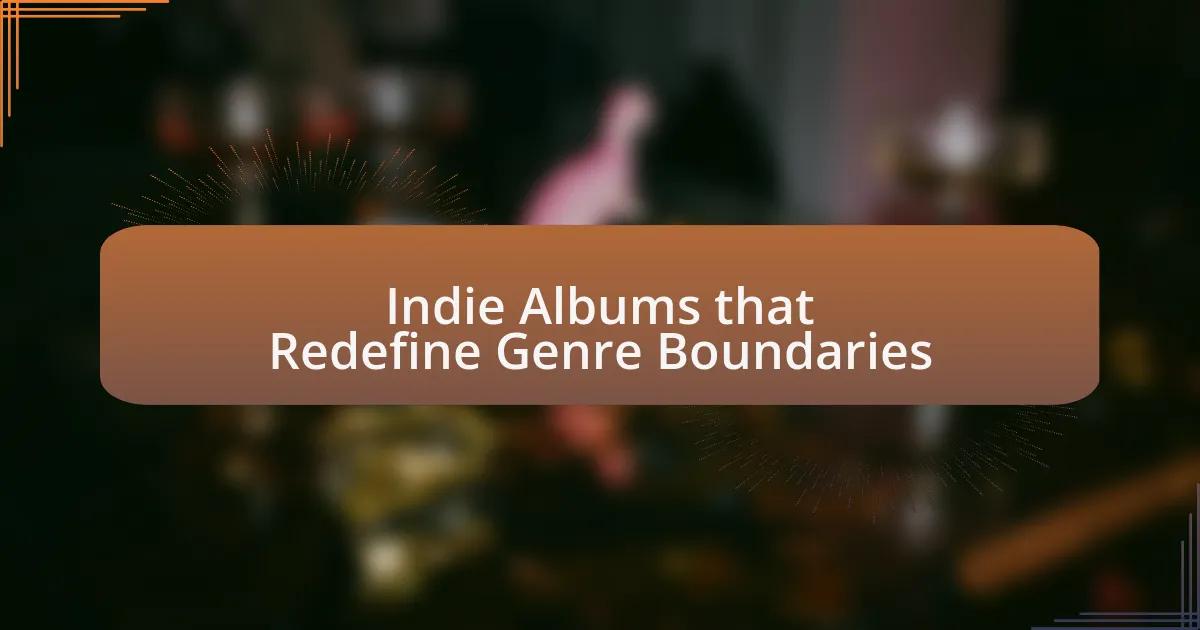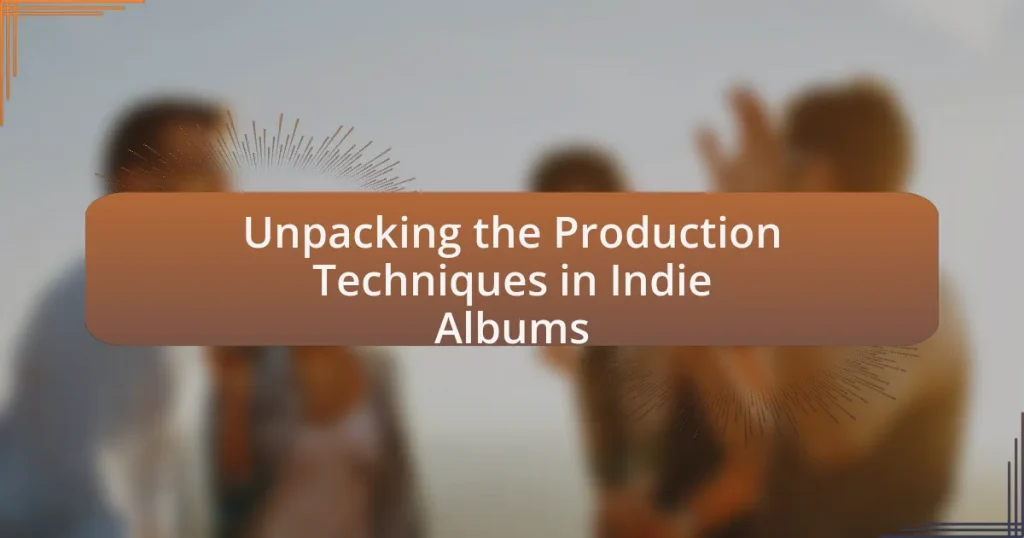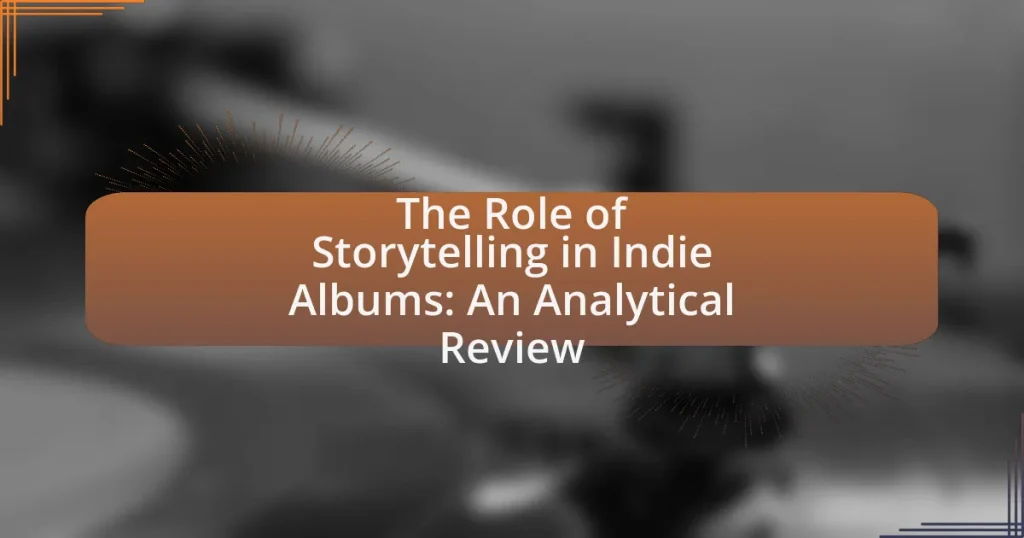Indie albums that redefine genre boundaries are characterized by their innovative blending of diverse musical styles, challenging traditional genre classifications. Notable examples include “In the Aeroplane Over the Sea” by Neutral Milk Hotel, “Kid A” by Radiohead, and “The Suburbs” by Arcade Fire, each showcasing unique soundscapes that incorporate elements from rock, electronic, folk, and more. These albums not only influence emerging artists but also promote a more inclusive music culture, encouraging listeners to explore a wider range of sounds. The article examines the characteristics that make these albums genre-defying, their significance in the music industry, and the impact they have on listeners and music culture.
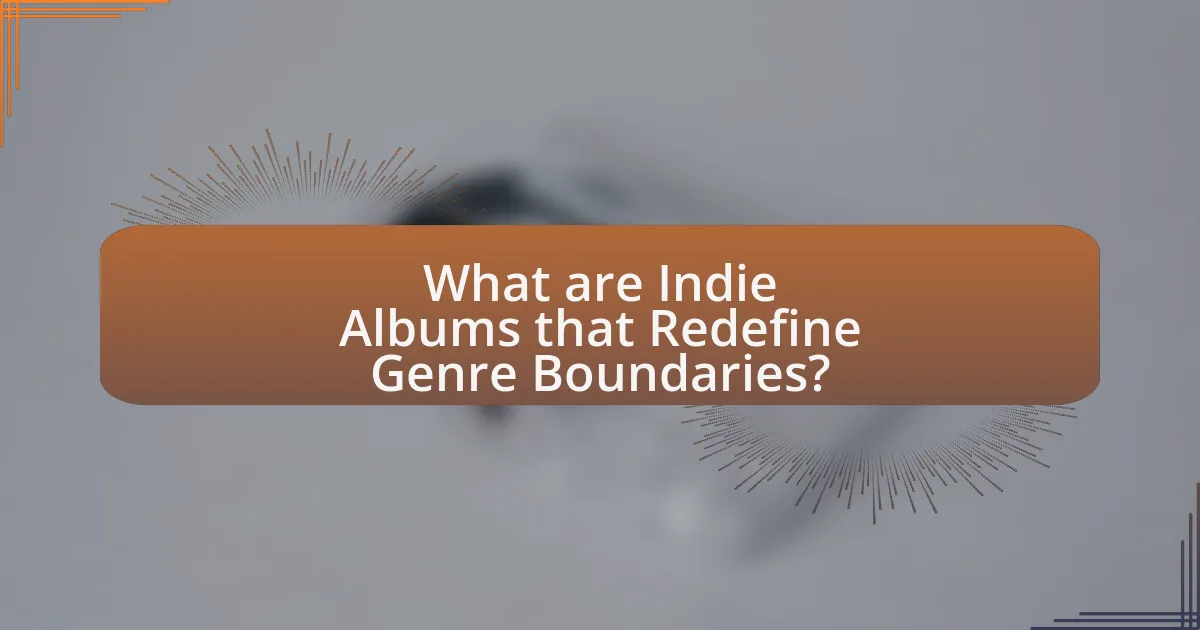
What are Indie Albums that Redefine Genre Boundaries?
Indie albums that redefine genre boundaries include “In the Aeroplane Over the Sea” by Neutral Milk Hotel, which blends folk, rock, and lo-fi elements, creating a unique sound that influenced countless artists. Another significant album is “Kid A” by Radiohead, which incorporates electronic music, jazz, and classical influences, challenging traditional rock norms. Additionally, “The Suburbs” by Arcade Fire merges baroque pop with indie rock and themes of suburban life, showcasing a diverse sonic palette. These albums are recognized for their innovative approaches, pushing the limits of genre classification and inspiring future musicians.
How do these albums challenge traditional genre classifications?
These albums challenge traditional genre classifications by blending elements from multiple genres, creating unique soundscapes that defy categorization. For instance, artists often incorporate aspects of rock, electronic, folk, and hip-hop within a single album, resulting in a hybrid style that cannot be easily labeled. This genre fluidity is exemplified by albums like “Bon Iver” by Bon Iver, which combines indie folk with electronic influences, and “Currents” by Tame Impala, which merges psychedelic rock with pop and R&B elements. Such innovative approaches not only expand the sonic possibilities but also reflect the evolving nature of music consumption, where listeners increasingly favor diverse and eclectic sounds over rigid genre definitions.
What characteristics make an album genre-defying?
An album is considered genre-defying when it incorporates diverse musical styles that challenge traditional genre classifications. Such albums often blend elements from various genres, such as rock, jazz, electronic, and folk, creating a unique sound that resists easy categorization. For example, the album “Kid A” by Radiohead combines electronic music with rock and jazz influences, illustrating how genre-defying albums can push the boundaries of conventional music genres. Additionally, genre-defying albums frequently experiment with song structures, instrumentation, and lyrical themes, further distinguishing them from typical genre-specific works.
How do artists blend different musical styles in these albums?
Artists blend different musical styles in these albums by incorporating elements from various genres, creating a unique sound that transcends traditional boundaries. For example, artists may fuse rock with electronic music, as seen in albums like “Random Access Memories” by Daft Punk, which combines disco, funk, and rock influences. This blending often involves the use of diverse instrumentation, innovative production techniques, and collaborative efforts with musicians from different genres, allowing for a rich tapestry of sounds. The result is a genre-defying experience that appeals to a broader audience and challenges conventional music categorization.
Why are these albums significant in the music industry?
These albums are significant in the music industry because they challenge and expand traditional genre classifications, fostering innovation and diversity in sound. By blending elements from various genres, such as rock, electronic, and folk, these indie albums create new musical landscapes that resonate with a broader audience. For instance, albums like “In the Aeroplane Over the Sea” by Neutral Milk Hotel and “For Emma, Forever Ago” by Bon Iver have not only achieved critical acclaim but have also influenced countless artists across different genres, demonstrating their lasting impact on the music scene. This genre-defying approach encourages experimentation and inspires emerging musicians to explore beyond conventional boundaries, ultimately shaping the future of music.
What impact do they have on listeners and music culture?
Indie albums that redefine genre boundaries significantly influence listeners and music culture by promoting diversity and innovation in sound. These albums challenge traditional genre classifications, encouraging listeners to explore a broader range of musical styles and influences. For instance, the album “In the Aeroplane Over the Sea” by Neutral Milk Hotel blends elements of folk, rock, and experimental music, which has inspired a generation of artists to experiment with their own sound. This genre-blurring approach fosters a more inclusive music culture, where artists feel empowered to break away from conventional norms, leading to the emergence of new subgenres and collaborative projects. The impact is evident in the rise of diverse music festivals and platforms that celebrate eclectic sounds, reflecting a shift in listener preferences towards more varied and innovative musical experiences.
How do they influence emerging artists and genres?
Indie albums that redefine genre boundaries influence emerging artists and genres by providing innovative soundscapes and blending diverse musical styles. These albums often challenge traditional genre classifications, encouraging new artists to experiment with their own sound and explore unconventional combinations. For example, the album “Bon Iver” by Bon Iver incorporates elements of folk, electronic, and R&B, inspiring emerging musicians to break away from genre constraints and create unique fusions. This trend is supported by the rise of platforms like Bandcamp and SoundCloud, which allow artists to share genre-defying music and reach wider audiences, further promoting the evolution of musical genres.
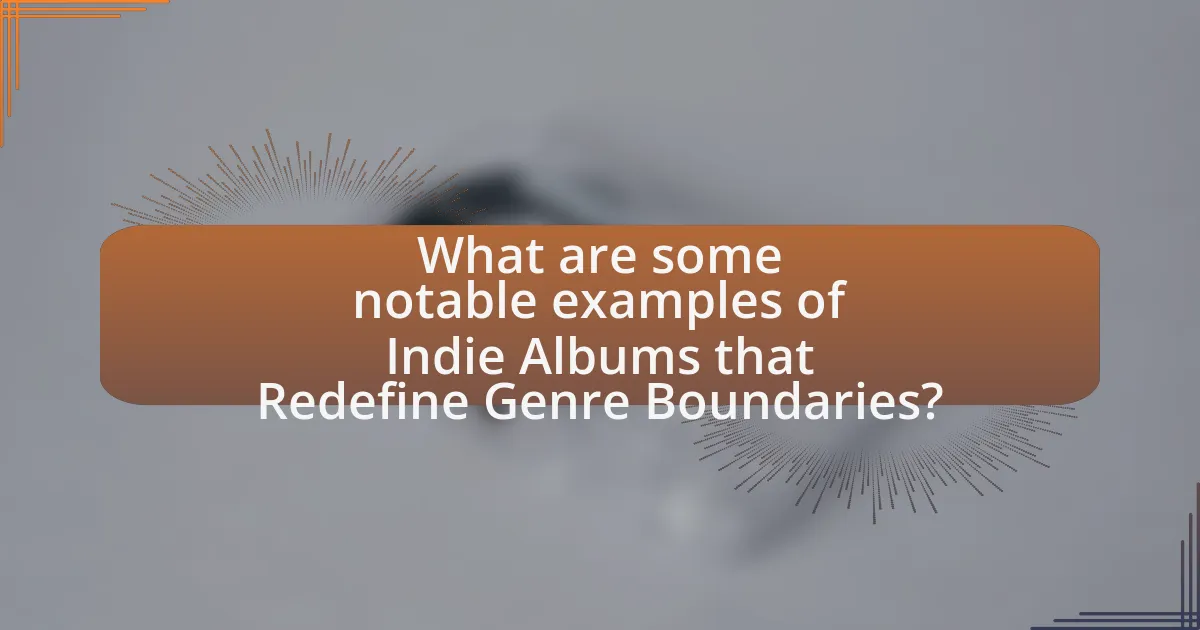
What are some notable examples of Indie Albums that Redefine Genre Boundaries?
Notable examples of indie albums that redefine genre boundaries include “In the Aeroplane Over the Sea” by Neutral Milk Hotel, which blends elements of folk, rock, and avant-garde; “Kid A” by Radiohead, which incorporates electronic music, jazz, and classical influences; and “The Suburbs” by Arcade Fire, which merges baroque pop with post-punk and art rock. These albums are recognized for their innovative soundscapes and lyrical depth, pushing the limits of traditional genre classifications. For instance, “In the Aeroplane Over the Sea” is often cited for its unique instrumentation and emotional storytelling, while “Kid A” marked a significant departure from Radiohead’s earlier work, embracing a more experimental approach.
Which albums are frequently cited as genre-defining?
Albums frequently cited as genre-defining include “OK Computer” by Radiohead, “The Velvet Underground & Nico” by The Velvet Underground, and “Is This It” by The Strokes. “OK Computer,” released in 1997, is often recognized for its innovative blend of rock and electronic music, influencing countless artists and shaping the alternative rock genre. “The Velvet Underground & Nico,” released in 1967, is credited with pioneering art rock and influencing the punk and indie scenes. “Is This It,” released in 2001, is noted for revitalizing garage rock and shaping the sound of the early 2000s indie music movement. These albums are consistently referenced in discussions about their respective genres due to their lasting impact and critical acclaim.
What elements of these albums contribute to their genre-defying status?
The elements that contribute to the genre-defying status of these indie albums include innovative instrumentation, eclectic influences, and unconventional song structures. Innovative instrumentation often incorporates non-traditional instruments or electronic elements, which broadens the sonic palette and challenges genre norms. Eclectic influences draw from various musical styles, such as blending rock, jazz, and electronic music, creating a unique sound that resists categorization. Unconventional song structures, such as irregular time signatures or unexpected shifts in tempo, further disrupt traditional genre expectations. These elements collectively enable the albums to transcend conventional boundaries, as evidenced by critical acclaim and listener engagement across diverse musical communities.
How have critics and fans responded to these albums?
Critics and fans have responded positively to indie albums that redefine genre boundaries, often praising their innovative sound and artistic experimentation. For instance, albums like “In the Aeroplane Over the Sea” by Neutral Milk Hotel have received critical acclaim for their unique blend of folk and lo-fi aesthetics, with critics highlighting its emotional depth and lyrical complexity. Fans have similarly embraced these albums, often citing their ability to challenge conventional genre classifications and resonate on a personal level. This positive reception is reflected in high ratings on platforms like Pitchfork and Metacritic, where many of these albums have achieved scores above 8 out of 10, indicating strong approval from both critics and listeners.
What genres do these albums typically blend?
These albums typically blend genres such as indie rock, folk, electronic, and pop. For instance, many indie albums incorporate elements of folk instrumentation alongside electronic beats, creating a unique sound that challenges traditional genre classifications. This blending is evident in works by artists like Sufjan Stevens, who merges orchestral arrangements with indie rock, and Bon Iver, who combines folk melodies with electronic production techniques. Such genre fusion not only expands the musical landscape but also attracts diverse audiences, reflecting the evolving nature of contemporary music.
How do these genre combinations create unique listening experiences?
Genre combinations create unique listening experiences by blending diverse musical elements, which enhances emotional depth and broadens sonic landscapes. For instance, the fusion of indie rock with electronic music introduces innovative sound textures and rhythms, engaging listeners in unexpected ways. This cross-pollination allows artists to explore themes and styles that resonate with a wider audience, as seen in albums like “In the Aeroplane Over the Sea” by Neutral Milk Hotel, which combines folk, rock, and avant-garde influences. Such genre-blurring not only challenges traditional categorizations but also invites listeners to experience music in a more immersive and multifaceted manner.
What are some specific tracks that exemplify these blends?
Specific tracks that exemplify genre blends in indie albums include “Sleepyhead” by Passion Pit, which combines elements of synth-pop and indie rock, and “Electric Feel” by MGMT, merging psychedelic rock with electronic music. Additionally, “Take Me Out” by Franz Ferdinand showcases a blend of post-punk revival and dance-rock. These tracks illustrate the innovative fusion of styles characteristic of indie music that challenges traditional genre classifications.
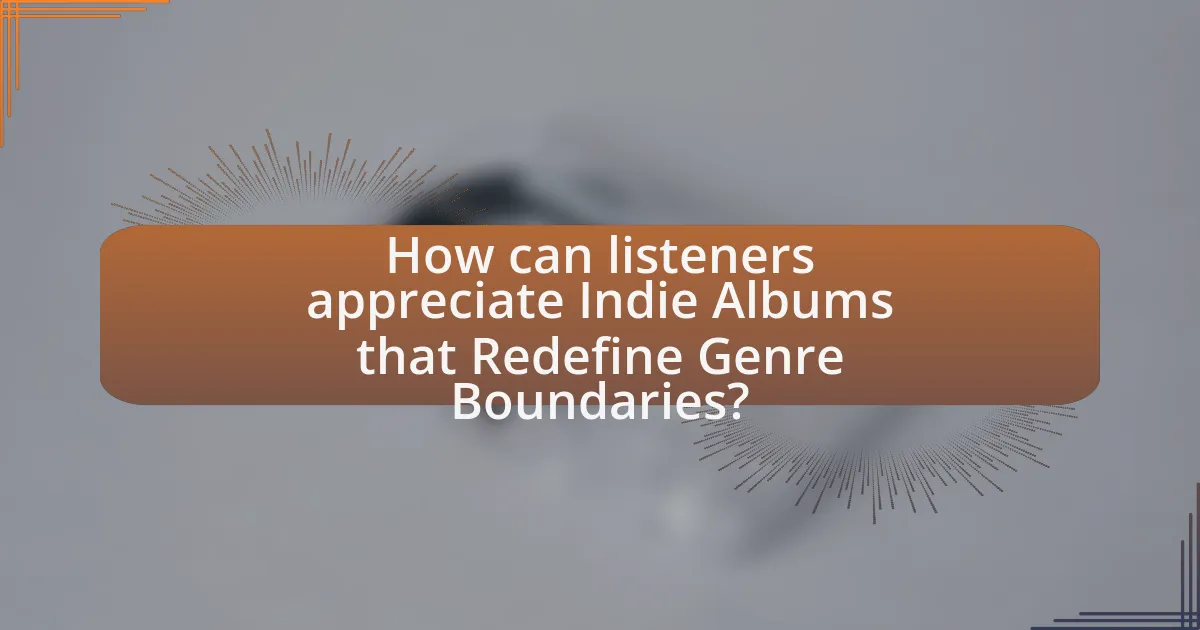
How can listeners appreciate Indie Albums that Redefine Genre Boundaries?
Listeners can appreciate Indie albums that redefine genre boundaries by actively engaging with the music and exploring its diverse influences. This engagement involves recognizing the innovative elements that blend various genres, such as the incorporation of electronic sounds in folk music or the fusion of rock with hip-hop rhythms. Research indicates that listeners who approach music with an open mind and a willingness to explore unfamiliar sounds tend to have a deeper appreciation for genre-defying works. For instance, albums like “The Suburbs” by Arcade Fire and “Channel Orange” by Frank Ocean have received critical acclaim for their genre-blending characteristics, showcasing how diverse influences can create unique listening experiences. By understanding the context and artistic intent behind these albums, listeners can enhance their appreciation for the creativity and experimentation that define the Indie genre.
What should listeners look for when exploring these albums?
Listeners should look for innovative soundscapes and genre-blending elements when exploring indie albums that redefine genre boundaries. These albums often incorporate diverse musical influences, such as combining rock with electronic, folk with hip-hop, or jazz with pop, creating unique auditory experiences. For instance, albums like “In the Aeroplane Over the Sea” by Neutral Milk Hotel showcase a fusion of lo-fi production and surreal lyrics, while “Currents” by Tame Impala merges psychedelic rock with electronic music, illustrating the creative possibilities within the indie genre. By paying attention to these elements, listeners can appreciate the artistic experimentation that characterizes these boundary-pushing works.
How can understanding the context enhance the listening experience?
Understanding the context enhances the listening experience by providing listeners with background information that informs their interpretation of the music. When listeners are aware of the cultural, historical, or personal circumstances surrounding an indie album, they can better appreciate the artist’s intentions and the themes explored in the work. For instance, knowing that an album was created during a time of social upheaval can deepen the emotional resonance of the lyrics and sound. Research indicates that contextual knowledge can significantly influence how music is perceived, as it allows listeners to connect more deeply with the narrative and emotional layers of the album, ultimately leading to a richer and more meaningful listening experience.
What are some tips for discovering new genre-defying artists?
To discover new genre-defying artists, explore platforms like Bandcamp and SoundCloud, which feature independent musicians pushing traditional boundaries. Engaging with music blogs and playlists that focus on experimental sounds can also lead to finding innovative artists. Additionally, attending local music festivals or showcases often highlights emerging talent that blends genres. Research indicates that genre-blending artists often gain traction through social media, making platforms like Instagram and TikTok valuable for discovering new sounds.
What resources are available for exploring these albums further?
Resources available for exploring indie albums that redefine genre boundaries include music streaming platforms, artist interviews, and music review websites. Streaming platforms like Spotify and Apple Music offer curated playlists and recommendations based on genre-blending albums, allowing listeners to discover similar artists and tracks. Artist interviews found on platforms such as Pitchfork and NME provide insights into the creative processes behind these albums, enhancing understanding of their genre-defying elements. Additionally, music review websites like Metacritic aggregate critical reviews and ratings, offering a comprehensive view of how these albums are perceived in the music community.
Which platforms offer curated playlists of genre-defying music?
Spotify, Apple Music, and Tidal offer curated playlists of genre-defying music. These platforms feature playlists specifically designed to showcase innovative and boundary-pushing tracks that blend multiple genres, appealing to diverse musical tastes. For instance, Spotify’s “Fresh Finds” and Apple Music’s “Alternative R&B” playlists highlight emerging artists and unconventional sounds, while Tidal’s “Genre-Bending” playlist focuses on tracks that defy traditional genre classifications.
How can music festivals and events showcase these innovative albums?
Music festivals and events can showcase innovative albums by featuring live performances from the artists behind these albums, allowing audiences to experience the unique sound and genre-blending characteristics firsthand. For instance, festivals like Coachella and SXSW have a history of highlighting emerging indie artists, providing them a platform to perform their groundbreaking work. Additionally, curated stages dedicated to genre-defying music can attract diverse audiences, enhancing the visibility of these innovative albums. The inclusion of panel discussions or workshops focused on the creative process behind these albums can further engage attendees, fostering a deeper understanding of the artistic vision. This approach not only promotes the albums but also encourages dialogue about the evolution of music genres.
